The Boswell Collection in New Orleans
By Cynthia Lucas
“New Orleans needs the Boswell Sisters and you’re going to help them get ‘em”
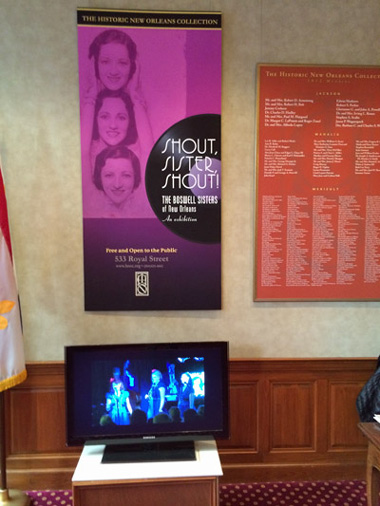 “Shout, Sister, Shout,” an exhibit dedicated to New Orleans’ Boswell Sisters, opened in five rooms of the Historic New Orleans Collection at 533 Royal Street on March 19, 2014. The exhibit was primarily drawn from the archives of the Boswell Museum of Music and marked the first time that a major New Orleans museum had honored the enduring musical legacy of the Boswell Sisters. Nearly 90 years since their first recording in a practice room at Werlein’s Music on Canal Street, the three women who developed the widely influential jazz harmony singing style which came to be known as “Boswell Rhythm” and “the Boswell Sound” were finally getting the recognition they deserved. This validation, not only from their native city but from the world at large, is a victory for devotees of the music like the Pfister Sisters, who had kept the art form alive. It was a victory for researchers like David McCain, Randall Riley, Jan Shapiro, Richard Sudhalter, Scott Yanow and many others whose research and restoration shed light on the lives and techniques of the Sisters.
“Shout, Sister, Shout,” an exhibit dedicated to New Orleans’ Boswell Sisters, opened in five rooms of the Historic New Orleans Collection at 533 Royal Street on March 19, 2014. The exhibit was primarily drawn from the archives of the Boswell Museum of Music and marked the first time that a major New Orleans museum had honored the enduring musical legacy of the Boswell Sisters. Nearly 90 years since their first recording in a practice room at Werlein’s Music on Canal Street, the three women who developed the widely influential jazz harmony singing style which came to be known as “Boswell Rhythm” and “the Boswell Sound” were finally getting the recognition they deserved. This validation, not only from their native city but from the world at large, is a victory for devotees of the music like the Pfister Sisters, who had kept the art form alive. It was a victory for researchers like David McCain, Randall Riley, Jan Shapiro, Richard Sudhalter, Scott Yanow and many others whose research and restoration shed light on the lives and techniques of the Sisters.
For me, it was a dream, or maybe a calling, come true.
For me, it was a dream, or maybe a calling, come true.
I told Vet “Chica” Minnerly that the Boswell Museum of Music collection needed to be in New Orleans shortly after we first met in 2006. It was something I had “known” since the first time I heard the Boswell Sisters’ music, a life-changing event that happened in early December, 2005.
In the aftermath of Katrina I had been working with evacuees from New Orleans, a city I had learned to love dearly. The inevitable flood washed away so many dreams, so many artifacts and so much hope. Something inspired me to purchase two Boswell CDs and I was blown away by the soulful, skillful, joyous genius of their music. While I had never heard anything quite like it, there was no doubt in my mind that their work represented something intrinsic to the culture of the Crescent City. Almost immediately I knew: New Orleans needed the Boswell Sisters, and I was going to help the city get them back!
That commitment led me to begin promoting and producing Boswell-inspired events in New Orleans. The first was the commemoration of the 70th anniversary of the last recording of the Boswell Sisters. The Pfister Sisters placed blind faith in me and we turned a Sunday brunch gig into a standing room only event with the press on hand. The evening before the gig I got a call from an unlisted number – it was Chica Minnerly, Vet Boswell’s daughter, thanking us for the celebration and wishing the Pfisters success. This was the beginning of a friendship that l came to cherish.
 Over the years I visited Chica in her upstate New York farm many times. She was encouraging when I produced the 2007 Boswell Sisters Centennial in NOLA, and even provided some family photos for display at the Cabildo. Our conversation often turned to what would become of the Boswell Museum collection. The idea for a museum dawned on Chica after she had retired and moved from Peekskill, New York to a farm further upstate in East Springfield. Chica got as far as actually purchasing a building to house the collection, but came to realize that operating costs made the idea of a physical museum impractical. Even so, the word got out, especially among fans and jazz educators, and Chica was visited by occasional researchers and scholars, who were given some access to the archives. But the collection – from all three sisters – was essentially locked away and unavailable.
Over the years I visited Chica in her upstate New York farm many times. She was encouraging when I produced the 2007 Boswell Sisters Centennial in NOLA, and even provided some family photos for display at the Cabildo. Our conversation often turned to what would become of the Boswell Museum collection. The idea for a museum dawned on Chica after she had retired and moved from Peekskill, New York to a farm further upstate in East Springfield. Chica got as far as actually purchasing a building to house the collection, but came to realize that operating costs made the idea of a physical museum impractical. Even so, the word got out, especially among fans and jazz educators, and Chica was visited by occasional researchers and scholars, who were given some access to the archives. But the collection – from all three sisters – was essentially locked away and unavailable.
In one of those trips to New York (with my Boswellian travel mates David McCain and Randall Riley) I had the great luck to discover one of Connie’s wheelchairs that had been left in the attic of Martha’s farm. It took nearly a year for me to negotiate the release of the chair and, when I went to New York to pick it up, I was also able to procure a trunk the Sisters’ had used in their touring days. I gave the wheelchair to Chica for the museum, and shipped the trunk back to Texas for my personal enjoyment. It was not long after the gift of the wheelchair that Chica invited me to become a trustee of the Museum.
Chica was a very particular lady and did not come to make decisions with any haste. Although she was interested in seeing the Museum collection go to New Orleans, just where it should go became a long pondered issue. There were many excellent venues in the city and I assisted Chica with making contacts at various institutions. It appeared that the selection of a recipient for the collection had been made, but a series of roadblocks began to impede the process. After a very disappointing meeting with the apparent recipient-to-be, I acted on the advice of a retired friend who knew the museum and collection world of New Orleans well.
I knocked on the door of the Historic New Orleans Collection.
The story of my personal Boswell saga has been all about doors opening and things happening in an almost magical way. So it was with the Historic New Orleans Collection. Despite my unannounced visit to the Williams Research Center of the HNOC, I was immediately treated to a tour of the facility and the keen interest of Mark Cave, Senior Curator/Oral Historian and Alfred Lemon, the center’s Director. I was so impressed with the wonderful access that the Williams Research Center could give to research, the exhibit space, the top-of-the-line archival storage, and the devotion to the city of New Orleans that I knew this was the place the Boswell collection should call home.
Chica was torn. She felt she had committed to another institution but they had been unresponsive and unwilling to even come examine the collection. Her health was failing and I think she knew that time was short. She finally agreed that the HNOC would be the right choice, but time ran out before she could make the transition. Chica’s daughter, Kyla Titus, was kind enough to let me speak with her mother on her last day. I promised her that I would make sure the collection went to New Orleans, and that I would continue to work to honor the Boswell Sisters.
The Trustees of the Boswell Museum of Music nominated me to be its president, and it was in that capacity that Kyla Titus and I oversaw the transfer of the Boswell Museum of Music collection to the HNOC. When the “Shout, Sister, Shout” exhibit opened in March 2014, I knew that Chica would be so pleased. I was delighted to see what a wonderful job the HNOC had done in presenting the collection with all its wonderful ephemera, photos and fan mail to the public. It was truly incredible that such a collection (and it is vast) survived.
 I would like to personally thank the HNOC’s Priscilla Lawrence, Executive Director, John Lawrence, Director of Museum Programs, Goldie Lanaux, Head Registrar, Aimee Everrett, Assistant Manuscripts Curator, and all the others who, along with Mark Cave and Alfred Lemon, made this exhibit possible. The videos, the wall treatments, the displays and music made this a fascinating and affecting experience.
I would like to personally thank the HNOC’s Priscilla Lawrence, Executive Director, John Lawrence, Director of Museum Programs, Goldie Lanaux, Head Registrar, Aimee Everrett, Assistant Manuscripts Curator, and all the others who, along with Mark Cave and Alfred Lemon, made this exhibit possible. The videos, the wall treatments, the displays and music made this a fascinating and affecting experience.
And right at the entrance: Connie’s wheelchair and the trunk David and I had pulled from Martha’s attic. I had come full circle. If it sounds like bragging, maybe it is. But, doggone, I’ve done it. And sometimes it’s OK to sing it out.
The exhibit is open through October 26, 2014, and Kyla Titus is gathering performers of the Boswell music from across the world for a cultural exchange that is open to the public October 9-11, 2014. For more information visit theBoswellSisters.com.
More pictures from the HNOC exhibit:
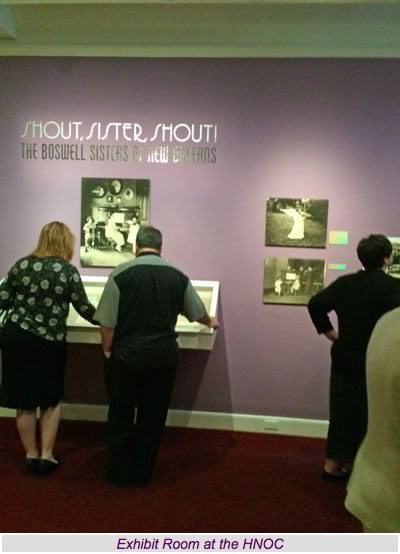

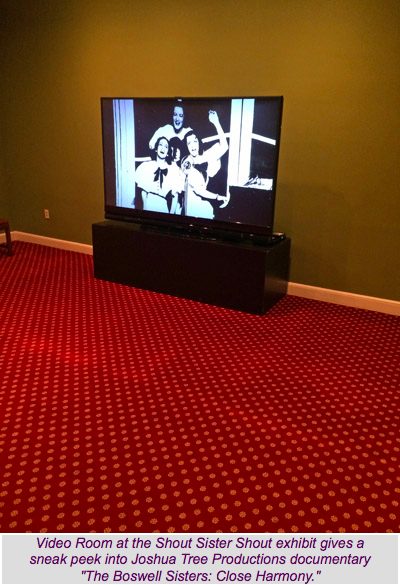
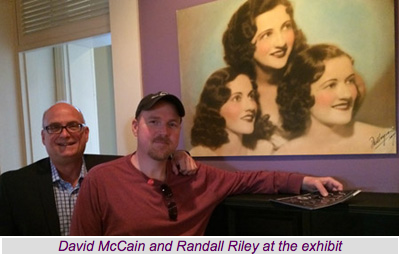
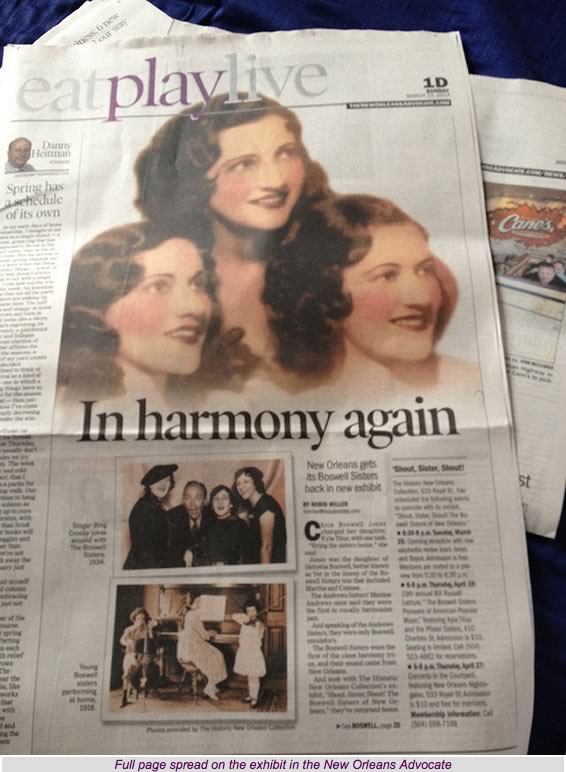
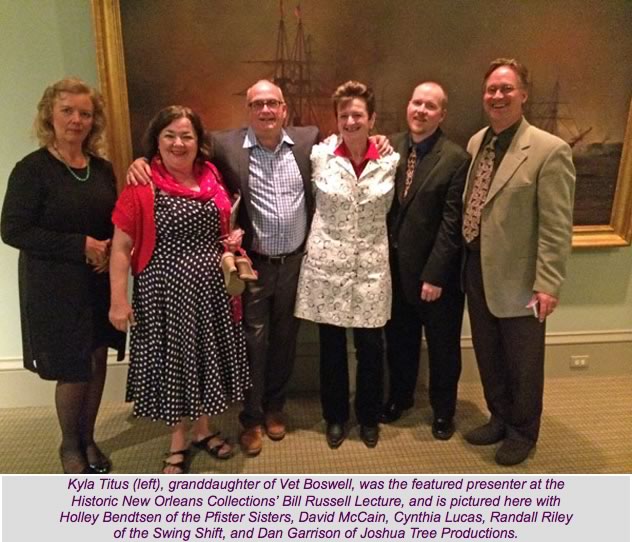
Cynthia Lucas is a marketer, writer and adventurer who lives near Austin, Texas.

 I promised her (Chica) that I would make sure the collection went to New Orleans, and that I would continue to work to honor the Boswell Sisters.
I promised her (Chica) that I would make sure the collection went to New Orleans, and that I would continue to work to honor the Boswell Sisters.

